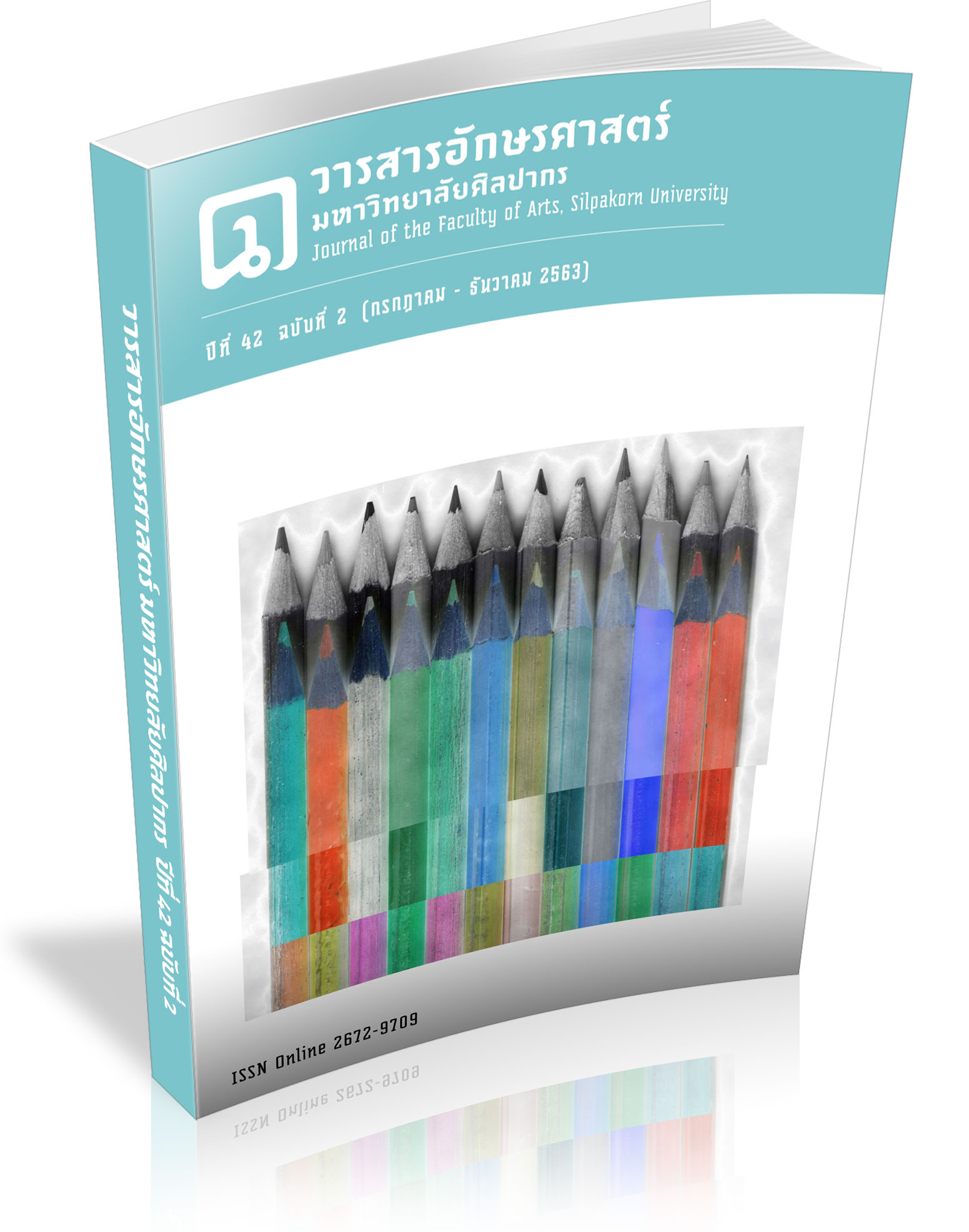A Linguistic Understanding of the Poetic Travelogue Niraat London
A Reflection of Language Use and Change
Keywords:
literary linguistics, linguistic change, historical linguistics, diachronic study, Niraat LondonAbstract
This article focuses on the relationship between language and the meaning of Niraat London, which was characterized and structured according to the era. Linguistic changes at the levels of morphology, word use and syntax in Niraat London are challenging to read and interpret for those who use current principles of analysis to analyze past texts without reviewing the issue of language use in different periods. This defect is resolved by incorporating the concept of historical linguistics into consideration. Eventually, it has become interdisciplinary in the academic and research world, which is so-called literary linguistics. Although the use of linguistics in this research is employed, the sequences of ideas are presented as a literary study in order to access the coordination between disciplines, and explain each phenomenon by means of descriptive analysis, and conceptual argument. The findings are two outcomes namely 1) language characteristics such as word use and meaning including some changeable grammatical structures, and 2) story/content characteristics with reflections of thought and practice with regard to language use. Both language and content dimensions are the convergence of linguistic changes and modes of representation through Niraat London.
Downloads
References
Angkhaphanitchakit, C. (2018). Discourse Analysis. 2nd Ed. Bangkok: Thammasat University Press. (In Thai)
Aitchison, J. (1991). Language Change: Progress of Decay?. 2nd Ed. Cambridge: Cambridge University Press.
Anong (อนงค์). Retrieved 14 December 2019, from https://dictionary.sanook.com/search/dictth-th-pleang/อนงค์. (In Thai)
Anttila, Raimo. (1972). An Introduction to Historical and Comparative Linguistics. New York: MacMillan.
Bynon. T. (1977). Historical Linguistics. Cambridge: Cambridge University Press.
Burusphat, S. (2017). Historical Linguistics. Nakon Phathom, Thailand: Research Institute for Languages and Cultures of Asia, Mahidol University. (In Thai)
Chanawong, S. (2019). Conditional Sentences (Chapter 16). In S. Pojprasat (Ed.), English Structure. 2nd Ed. Nakhon Pathom: Faculty of Liberal Arts, Mahidol University.
Chokthawikit, S. (2017). An Analysis of Sound and Meaning in Literature: A Case Study of Niraat London. Journal of Language and Linguistics, 35(2), 45-76. (In Thai)
Chokthawikit, S. (2016a). Violence Disguised in Literature ‘Phra Aphai Mani Escaping the Giantess: An Integration of Approaches’. Electronic Proceeding of the National Conference on Humanities and Social Sciences ‘Unity and Diversity in Humanities and Social Sciences’, 1371-1388, held at Burapha University, Thailand on 10 June 2016. (In Thai)
Chokthawikit, S. (2016b). The Phenomenon of Present Thai Adolescences’ Vulgar Words: A Sociolinguistic Perspective. Electronic Proceeding of the National Conference on ‘Humanities: The Real and the Power of Dream’, 503-530, held at Chiang Mai University,Thailand on 14-15 November 2016. (In Thai)
Conditional clause. Retrieved from http://www.bbc.co.uk/learningenglish/course/intermediate/unit-24/session-2/activity-1, on 12 December 2019.
Culpeper, J. & Haugh, M. (2014). Pragmatics and the English language. Hampshire, England: Palgrave Macmillan.
Evans, V. & Green, M. (2014). Cognitive Linguistics: An Introduction. 5th Ed. Edinburgh: Edinburgh University Press.
Freeman, D. (2019). Linguistics in Literature. Retrieved from https://www.linguisticsociety.org/resource/linguistics-literature, on 14 December 2019.
Hockett, C. F. (1960). A Course in Modern Linguistics. New York: MacMillan.
Lakoff, G. & Johnson, M. (1980). Metaphor We Live By. Chicago: Chicago University Press.
Lowe, I. (1992). Conditional Clauses: Their Information Status and Discourse Function. In Shin Ja J. Hwang & William R. Merrifield (Eds.), Language in Context: Essays for Robert E. Longacre, Publication in Linguistics: Publication 107 by Summer Institute of Linguistics and The University of Texas at Arlington. Texas: International Academic Bookstore.
Mattiessen, Christian M.I.M. (2014). Halliday’s introduction to functional grammar. 4th Ed. London & New York: Routledge.
Modality. Retrieved from http://dictionary.cambridge.org/grammar/british-grammar/modals-andmodality/modality-introduction, on 1 September 2019.
MomRachothai. (Mom Ratchawong Kratai Itsarankun). (2010). Niraat London and Archive of Thai diplomats Travelling to England in the Reign of King Rama IV Edited Version. 4th Ed. Bangkok: Sayam. (In Thai)
Na Nagara, P. (1997). Descriptive Language: Developing and Destroying the Thai Language. Bangkok: Khaofang. (In Thai)
Phalawong, P. (2015). Introduction to Semantics. Bangkok: Ramkhamhaeng University Press. (In Thai)
Phingkharawat, N. (2008). The Change of Language: The English Language through the Timeline. Bangkok: Academic Publishing Project, Faculty of Arts, Chulalongkorn University. (In Thai)
Phoemcharoen, L. (2015). Morphology. In Srinarawat, D. & Bamrungrak, C. (Eds.), Language and Linguistics. Bangkok: Thammasat University Press. (In Thai)
Royal Institute of Thailand. (2013). Dictionary Royal Institute of Thailand Version 2011. Bangkok: Royal Institute of Thailand. (In Thai)
Royal Institute of Thailand. (2014). Linguistics Dictionary (Applied Linguistics) Royal Institute of Thailand Version. 2nd Ed. Bangkok: Royal Institute of Thailand. (In Thai)
Saralamba, C. (2007). Semantics, Copying Material. Bangkok: Department of Linguistics of Faculty of Liberal Arts, Thammasat University. (In Thai)
Sound symbolism checksheet. Ling 131: Language and style. (n. d.). Retrieved from http://www.lancaster.ac.uk/fass/projects/stylistics/topic5a/7soundchecksheet.htm, on 21 September 2019.
Thepkanchana, K. (2016). Grammaticalisation. Bangkok: Academic Publishing Project of Research Section of Faculty of Arts, Chulalongkorn University. (In Thai)
Thongkhamwan, Cham. (2000). Introduction to Thai Literature (The First Inscription of Sukhothai). 14th Ed. Bangkok: Ramkhamhaeng University Press. (In Thai)
The Virtual Theorist. (n. d.). Literary linguistics. Retrieved from http://blogs.bcu.ac.uk/virtualtheorist/literary-linguistics/, on 1 September 2019.
Wongthet, S. (2019). Sunthon Phu Performed the Hidden Agenda by King’s Order in Niraat Mueang Klaeng with Regard to the motto “Being King’s Servant until Death, Having to Do. Retrieved 26 September 2019, from https://www.matichon.co.th/columnists/news_189771. (In Thai)
Downloads
Published
How to Cite
Issue
Section
License
ผู้เขียนบทความต้องยินยอมในข้อกำหนดต่าง ๆ ของวารสารก่อนส่งบทความตีพิมพ์




